Two days ago I posted about a very tame juvenile male Prairie Falcon I photographed last week in the Centennial Valley of Montana. The bird had two bands and I was extremely curious about where, when and why the falcon was banded and by whom so I asked for any insight my readers might have about the bands. Several of you jumped in with advice and suggestions, for which I’m much appreciative.
But it was the superb sleuthing of my friend Mike Shaw that paid huge dividends. Mike did some research and learned that the colored band on the falcon (left foot) was issued to Doug Bell, Wildlife Program Manager for East Bay Regional Park District out of Oakland, California. On Tuesday, figuring that Doug might be interested in knowing that his California bird was now in the wilds of Montana, I emailed him with a link to that blog post and an offer to supply any more information about my encounter with that bird that he’d be interested in. I also asked him if he might tell me a little about his experience with the falcon.
Yesterday Doug responded generously with information and photos. Since many of my readers expressed an interest in knowing about the history of this young bird I decided to update you with a new post rather than add an addendum to the previous post that many might not see. Besides, there’s a lot of new “stuff” here.
Image property of East Bay Regional Park District – used by permission
Doug and his team banded “my” Prairie Falcon (along with two other male siblings) when it was a 24 day old nestling on May 31, 2013 in the Diablo Range about 30 miles east of San Francisco. These are those three youngsters on the day of banding. Doug took the photo while hanging from a rope. He noted that these chicks were originally in a stick nest that collapsed sometime in the week before banding (you can see remnants of the nest and how steeply the cliff drops off in front of the narrow ledge). Doug expected to find that stick nest when he reached the chicks but instead they were on this narrow, rock shelf. After surviving this experience and a trip to Montana as such a young bird Doug referred to my bird as a “true survivor”.
Image property of East Bay Regional Park District – used by permission
Doug took this photo of one of the adult birds while hanging from the rope.
Image property of East Bay Regional Park District – used by permission
Meet the banding team, minus Doug – (L-R) Joe DiDonato, Harvey Wilson and Erika Walther.
Image property of East Bay Regional Park District – used by permission
Here’s Erika with one of the three chicks. There’s a 50/50 chance that this youngster is my bird since only two of the chicks were banded silver on the right foot and green on the left (you can see the silver band on the right foot of this bird.
Image property of East Bay Regional Park District – used by permission
And this is Doug at a different nest site in 2011.
I enthusiastically endorse the work that Doug and his team are doing in support of Prairie Falcons. I’ll let him describe it in his own words:
“I have been studying the population genetics and biology of prairie falcons in California since 2002. I am especially interested in population sub-differentiation and how they use the landscape in regards to land management and human development. I have had two graduate students complete Master’s studies on prairie falcons and am in the process of writing those up for publication. The Park District and others have used the information from our studies to help identify and purchase some of the last best grasslands in the east SF Bay Area for open space. We are also concerned about the ongoing impacts of the Altamont Pass wind turbines on falcons and other raptors, especially golden eagles“.
Here’s a couple of other interesting tidbits:
- assuming that he fledged at about 38 days of age, this very young bird made it all the way to Montana less than 6 weeks later (and appeared to be thriving)
- team member Joe DiDonato had banded prairie nestlings in the east SF Bay area back in the 1990s and two of the nestlings wound up in Montana in their first summer as well
And here he is in all his glory, sitting on a fence post last week in southwest Montana – dried food on his bill and looking for more.
Prairie Falcons are a special species for me – they’re beautiful, tough, stubborn (Mark Runnels calls them “irascible”), incredibly skilled hunters and a hugely challenging quarry for the photographer because they’re nearly always difficult to approach. I became particularly enamored with “my” Montana bird when it let me get so close for so long.
And now that I know more about the history of that particular bird – well, I’m simply infatuated!
Ron



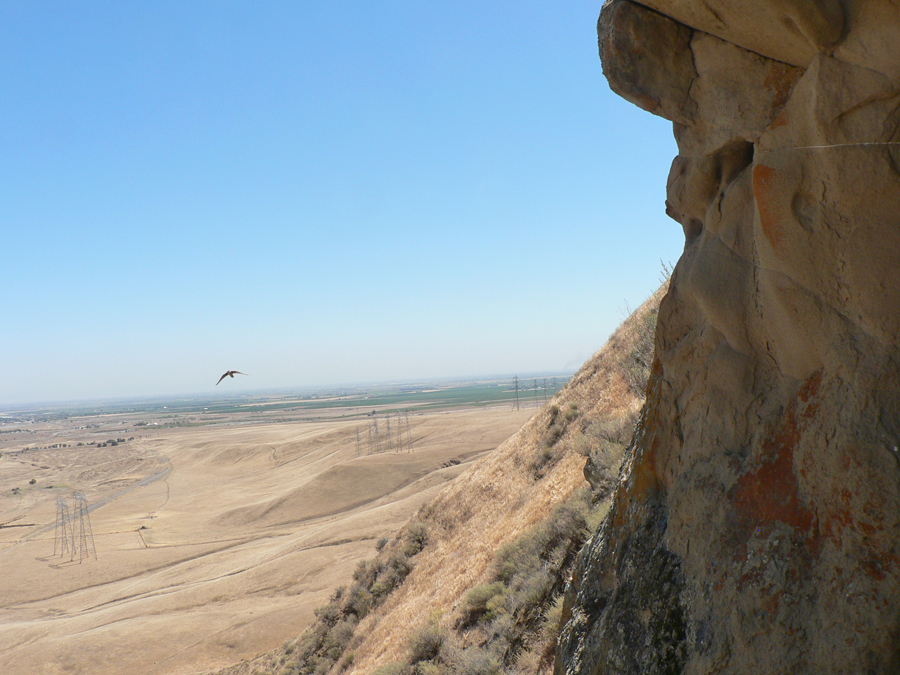
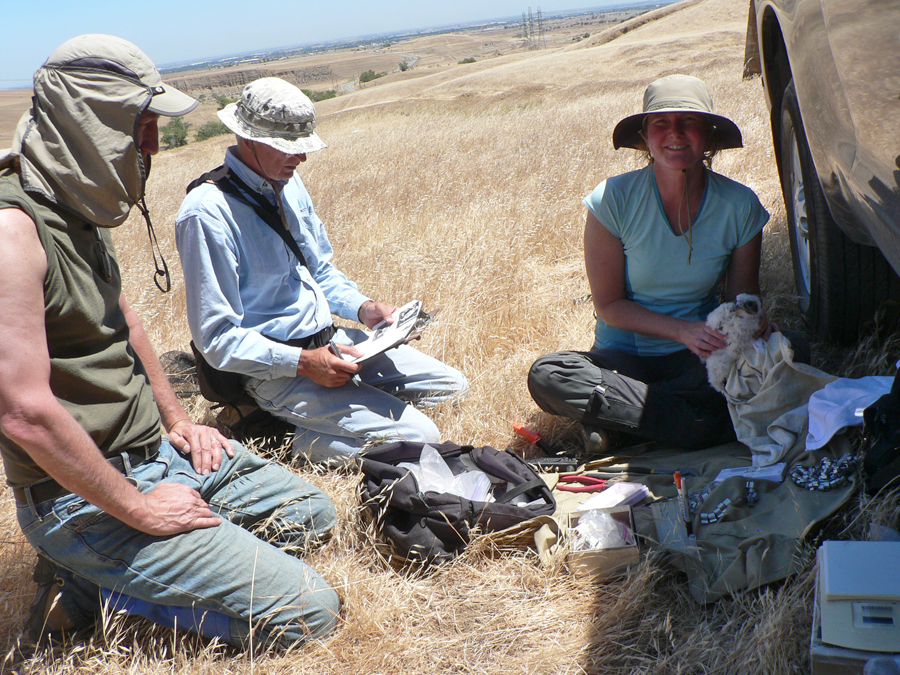
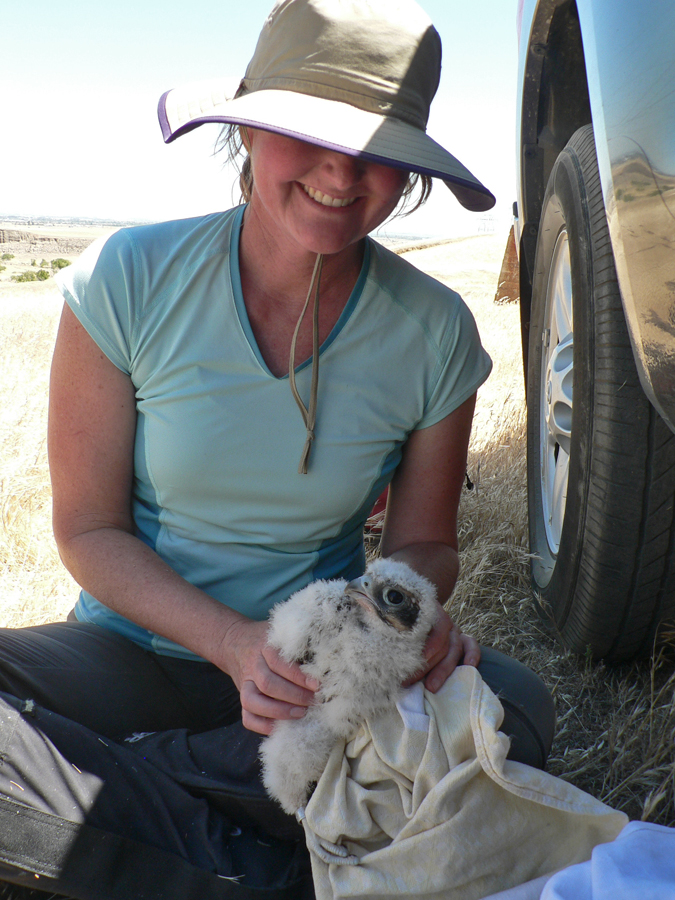
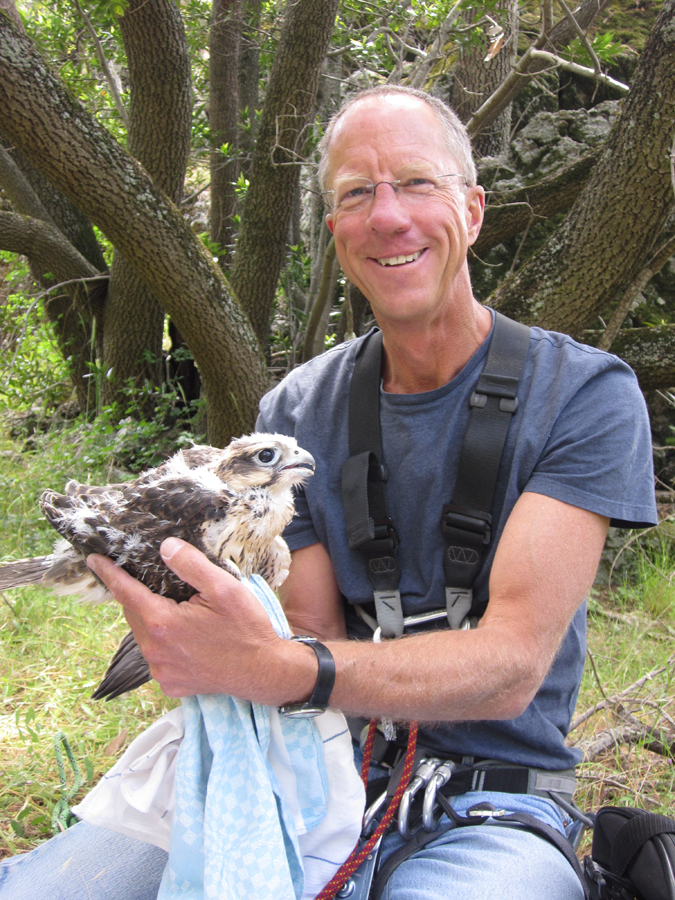
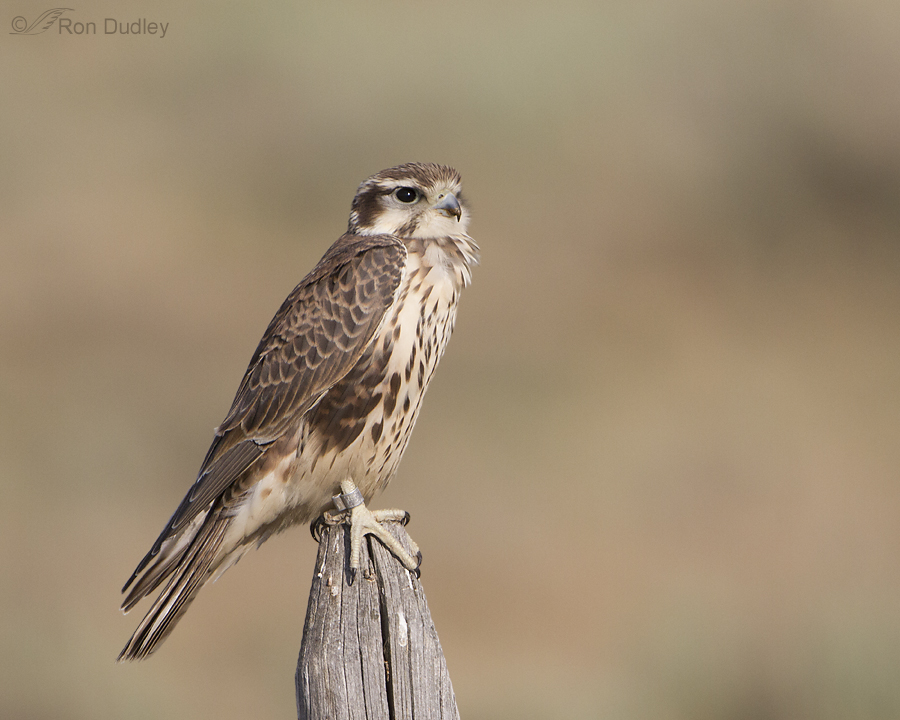
Thank you for this great story. I grew up on Mt. Diablo and now live on the prairie. You taught me something about both of my homes. Thanks!
I have trouble with an amount of the banding that is going on these days. Too invasive for the info collected. But I wholeheartedly am behind a project that goes beyond research into action. So if your banding supported lands being set aside as open space high five to you. Remember to select your research efforts carefully. A non-banded bird is a free bird and human curiosity does not warrant trapping/confining and banding.
What a wonderful story! So glad that you not only got the info., but generously passed it on. The photo simply wonderful particularly yours at the end of the post. It is heartwarming to know that there are folks out there like you and Doug and the rest of his team. Keep up the good work and thanks so much for sharing.
Charlotte Norton
What a wonderful story! Thank you very much for updating us on this beautiful, special bird.
Wow, Ron — what an amazing post and story. Like all of your other commenters, I love these full-circle stories as well. It provides a thread of continuity and connection, not just between the research and the outcome of the bird, but also between the bird’s experience and ours, when we finally encounter him or her. I especially loved that your falcon originated in my home turf, the San Francisco Bay Area! I spent a lot of time in the areas around where these babies were banded, and still, I’ve never seen a Prairie Falcon in person … well, not that I could identify. Fantastic and educational for me in so many ways.
Thanks for putting in the distance. That’s certainly quite a long way for a young bird to fly unharmed.
With regard to his tameness, I find immature birds at a certain age are more trusting than adults, and that some birds are more tolerant than others.
Yes Sonja many raptors seem uncommonly tolerant of their space just after fledging but I would have thought this fellow past that stage. But you are also right in that each member of a species is not a cookie-cutter of another.
Bill
You’re welcome, Sonja. Actually, several of the PRFA’s in the area were significantly more approachable than usual for the species. The only common denominator I’m aware of was the fact that they were all gorging themselves on grasshoppers – many feeding on the dirt/gravel roads and perching on the fence posts next to the road.
That is quite fascinating, and a wonderful photo!
Thanks, Scott.
Our NA falcons don’t build nests but will create what are referred to as a scrape (a slight depression to hold the clutch from rolling away)(a different nest to what we might have previously known). Some of our falcons will utilize a stick nest of another avian species as an alternative. Merlins, Aplomado, Prairies, Peregrines and Gyrs are those that may do so.
Bill
For several years I monitored Ferruginous Hawk nests in the same area of the Utah West Desert. It was a surprise one spring to find a pair of kestrels nesting in a previously active ferruge nest. They were tucked up into a gap in the side of the nest rather than incubating in the center, but it was still hilarious to see that pair of little falcons perched on a monster stick nest.
Mike: Interesting to learn. I have bred Kestrels, seen them use nest boxes and cliff nests but not a stick nest. Thanks for that.
Bill
Folks might enjoy viewing the video Tim (48Doger) posted a link to regarding banding of Prairie Falcons. The link can be found near the very bottom of the comments on THe Tamest Prarie Falcon.
A possible cause for the falcon’s “tameness” maybe his full crop and gizzard.
Bill
Interesting clip, Bill and Tim. I had no idea that some of these “nests” (typically they are no true nests involved with this species) are so deeply buried inside the cliffs.
You are a true falconer Ron…..and you have the partnership with a falcon to prove it.
These two posts show how passionate you are about the back story, the inside scoop, the behind the scenes so to speak.
True….it took a little help of friends to put the story together, but I like your ability to observe and ask questions.
Ron’s bird comes from where I live…..the Easy Bay. I’m so wrapped up in my love Red Tails,
I didn’t know that there are so many Parire Falcons near by. Thank goodness for your blog Ron!!
Tim
You’ve said some very nice words here, Tim – they’re much appreciated.
I hope you get to see some of the Prairie Falcons in your area now.
Fantastic saga! How wonderful you were able to “complete the circle” from sighting a bird to discovering his origins. That’s happened once for me and it was a special feeling. This is what it’s all about. Thank you for sharing, Ron!
I can tell that you “get it”, Wally – this truly did provide a special feeling.
What a wonderful story!!!! I love how your followers band together to help you unlock mysteries! This was such an amazing example of team work… in every way!
Thank you, Julia – and you’re exactly right. This would never have come together without the help of friends. And I thought your choice of terms (“band together”) was particularly appropriate for this post…
I LOVE these events! Thanks for the follow-up Ron and everybody. Other than by their peers and the professional journals, the work of raptor biologists is under-appreciated.
Agreed, Susan – raptor biologists certainly deserve more recognition than they get for their hard work and dedication to their birds.
I just got an email yesterday, Ron, from a fellow rehabilitator in the East Bay, saying the she had contacted Doug Bell, a friend of hers, and sent him the link to your blog that I had sent her, just a couple of days before you contacted him. Small world, eh?
Since prairies don’t make nests (or repair ones they take over), I would guess the stick nest that slipped off the cliff was originally maybe a hawk or raven’s nest – lucky for those babies they got off in time! And this still doesn’t explain why this photographed youngster was so unusually tolerant of you being so close … the photos of the nest site hardly seem to indicate a steady stream of human traffic that would build up such nonchalance. I would think the banding alone would make them less likely to tolerate humans. Maybe he’s just a naturally calm bird, for a prairie – may all humans he meet be as kind as you, Ron!
Wow, what a coincidence, Louise!
You must be correct, that the original stick nest was constructed by another species. I don’t know why he was so tame but I’m sure glad he was…
Ron, thanks so much for your determined sleuthing and sharing this story with us. I’m from Oakland and I think our East Bay Regional Parks District is one of the most wonderful in the world. I’m so happy to hear about the work being done here by Doug, his team, and others like him. Thank you for sharing “your” falcon with us!
Thank you, Sharon. Keep an eye on the sky for Prairie Falcons while you’re enjoying that wonderful park system.
Thanks for the update Ron. That is very interesting. I’m glad you learned the origins of “your” bird! The story is special to me because I spent many hours hiking and birding the East Bay Regional Park Districts trails during the 24 years I lived in the East Bay. I now live in Idaho Falls and it was fun to learn about happenings back in my old stomping grounds.
I’d never heard of “East Bay Regional Park” before all of this came down, Peggy. But when I did a little research it looks like their park system is huge and some of it is quit “wild”.
Ron, I’m thrilled you were able to get in touch with Doug and exchange info on this bird. You made a comment a couple of days ago about leg bands detracting from the image of a beautiful bird. I laughingly agree, but in this case it ended up adding a great story to your equally great image. Sometimes “more is more”. Lol. Thanks also for the insights into the work of Doug and his team. Their interesting research is not just adding to the body of Prairie Falcon knowledge, it’s having a direct conservation effect. The best kind of research IMHO.
We’ll be setting up our fall migration sites in the coming weeks and I’ll stay on the lookout for your Prairie with the green left 3 over 4!
This was a connection that never would have been made without your efforts, Mike – sincere thanks for that!
Wouldn’t that be something, if this bird turned up for you during fall migration!
Thanks to the wonderful team for their care and caring about this and other species. Fascinating story about this bird, hope he sticks around and gives you a few more good poses.
I’ll definitely be looking for him the next time I head for Montana, Lane.
What a wonderful PS, Ron … beautiful image of your sweetie … and I loved hearing (and seeing!) something of his history!!!! YAY!!!
Thanks very much, Lois.
Ron, Thank you to you, Doug, Don , and the banding team. Their work is largely done out of the public eye and your wonderful blog (and at least one of your followers) has given them a little bit of public recognition. Super.
Prairie Falcons are full-of-wonder. If one looks at the first image in the series and notes the birds’ size when they were 24 days old, the fact that “your” bird was in Montana just a few weeks later is mind-boggling. And, it “knew” (in a genetic way) where it was going, because it crossed over some pretty good Prairie Falcon habitat en route!
Now I’m wondering if that population returns to the East Bay in adulthood. Wondering lots of things, actually…
Thanks again,
Dick
Oops. I meant Doug, Joe and the team…
I agree, Dick – these folks don’t get the recognition they deserve.
That’s the neat thing about this kind of stuff – the more you learn the more you yearn for more…
Thank you for the update Ron and your fantastic photography.
Glad you enjoyed the post, John.
Thanks Ron for keeping us informed. I feel truly connected to this beautiful bird!
I feel the same connection, Nancy.
Great story, many thanks for sharing!
What a beautiful bird, love how this bird has survived.
Had a Kestrel when I was younger. Simply love falcons of all types!!
Got my life Gyr in 2000 and I still get excited when I think about that sighting.
Thank you, Dick.
Interesting to hear his story. They’re rather like our Brown Falcons to look at, so I’ll remember the story when I see one.
Roughly how far would it be from where he was banded to where you photographed him?
Sonja, it’s about 730 miles (as the “crow” flies) and crosses multiple mountain ranges.